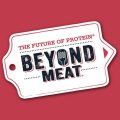Beyond Meat replaces animal protein with plant protein in their food products such as burgers and Chicken-Free Strips. In doing so, the company creates nutritional value at a lower cost with an improved environmental footprint.
Beyond Meat use naturally occurring vegetable proteins to create products that look, smell and taste like meat. The company started with Chicken-Free strips and have since moved on to create burgers and beefy crumble as meat alternatives for favourite family recipes. The Chicken-Free Strips use a plant protein that mimics the texture of real chicken and their ‘Beyond Burger’ contains pea protein combined with beetroot, to produce a remarkably meaty vegan experience.
Free of gluten, GMOs, cholesterol, trans-fats, hormones, and preservatives, the Beyond Meat products are packed with natural proteins, vitamins and minerals not found in red meat.
Would we continue to raise and eat animals in such staggering numbers if a delicious and perfect plant-based replication of meat existed? I decided to find out – and founded Beyond Meat.
Ethan Brown – Founder and CEO, Beyond Meat.
Why you should care
Americans consume half a pound of protein per day versus the recommended half a pound per week, and it is estimated that with growing GDP levels in Asia, protein demand per capita is likely to increase rapidly. Plant protein benefits human health while addressing critical issues of climate change, resource scarcity, and animal welfare. Beyond Meat’s manufacturing footprint is small enough to allow it to be replicated in any corner of the world. Relative to animal protein, Beyond Meat promises comparable nutrition at a lower cost with a lower environmental impact.
How the Global Goals are addressed
Good health and well-being
Beyond Meat’s products are GMO free and contain no cholesterol, hormones or preservatives, but still contain comparative protein levels to a traditional burger.
Clean water and sanitation
According to one study, it takes 200 liters of water to produce one quarter pounder hamburger, while producing plants and proteins requires far less.
Climate action
Globally, it is estimated that livestock agriculture accounts for 15% of our total greenhouse gas emissions. Changing diets towards plant based food could be part of the solution to cutting emissions from the industry.
Life on land
Using plants requires as much as 99% less land for producing burgers compared with traditional beef burgers, which need both grazing space and agricultural land to grow livestock feed.


